If the sea level continues to rise at the current rate, the Maldives will be the first country to cease to exist due to climate change. At 2.4 meters, it has the lowest high point in the world. Made up of over 1200 islands grouped over 26 atolls, it is the smallest country in Asia by both population and landmass. It is the first country in the world to aim to be carbon neutral by 2020, and tourism and “green taxes” provide a large source of income for the islands, which have seen tourism numbers double over the past ten years. Even with the threat of rising sea levels, there is still quite a lot of economic a activity going on here, such as skyscrapers being built, artificial islands being created, and metals being mined.

So if you want to see the Maldives, you better hurry! Since we were just in India for two months, we found that the budget airline Indigo has $116 fares to the Maldives, so we decided to visit. Visitors to the Maldives have three choices: a private island owned completely by a luxury resort, a local island populated by Maldivians with guest houses and small restaurants, or a live-aboard boat. We chose a local island.

Flying in, we could see the ring-shaped atolls, surrounded by coral reefs, from the airplane. We landed at Velana airport, which is situated on a completely man-made island. From there you can take a sea plane to a resort island (Maldives has the largest seaplane operations in the world), take a speedboat to any number of desired islands, or take a public ferry to Malè, the capital, which is located just next to the airport.
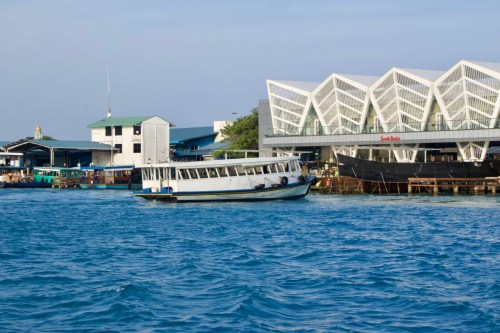
We stayed overnight in Malè, which is about 6 sq km and holds around 1/3 of the 500,000 Maldivian population. Male was originally founded by Dravidian people from southern India and Ceylon (Sri Lanka). It was a monarchy until 1968, and in that year the old palace and fort were destroyed. Only the home of the last sultan- now the National Museum building- and the Friday Mosque remain from ancient times.

The next morning, we took a speedboat to Thulusdhoo, a medium-sized island in the Kaafu atoll. Less than 1400 Maldivians live on the island, which is only 2.8 sq km. We stayed in a small guesthouse which served a delicious breakfast each morning, and we tried out a different local restaurant each evening. Maldivian specialties include masuni (flatbread served with shredded tuna and shaved coconut flavored with limes and onion and spices), and roshi (a mixture of sauce, chopped up flatbread, and fish/chicken/ or beef cooked together). Also on the island is a Coca Cola factory- the only one in the world that uses desalinized water.
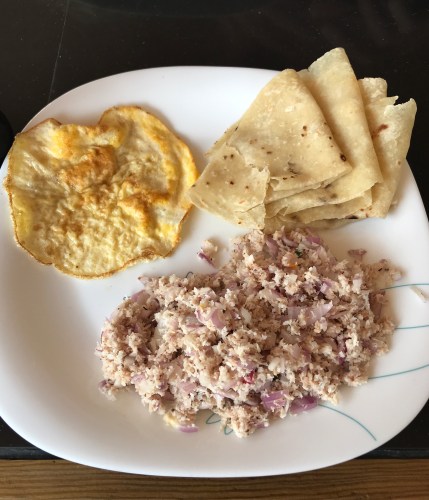
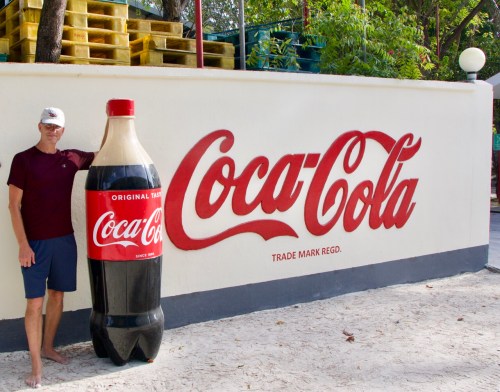
The Maldives make up 3% of the world’s coral reefs. So of course we went diving, and were able to see a tiger shark, lots of moray and honeycomb eels, black tip reef sharks, triggerfish, sting rays, eagle rays, tuna, batfish, sea turtles, and more. The corals are not very vibrant here- apparently a warm El Niño in 2015 and 2016 causes pretty severe loss of coral life. However, the array of aquatic life in the area is still one of the most diverse in the world.

 Chris and Deah, in between dives
Chris and Deah, in between divesAside from diving- and eating- we pretty much just… lounged around. We watched dolphins swim by. We read books, and played card games. We walked around the whole island, which only takes about 40 minutes. We watched snorkelers and paddle boarders. We could take a boat to a nearby resort island but we didn’t feel like it. Basically, we just enjoyed the sun, the cool breeze, lots of fresh Coca Cola, and relaxed.
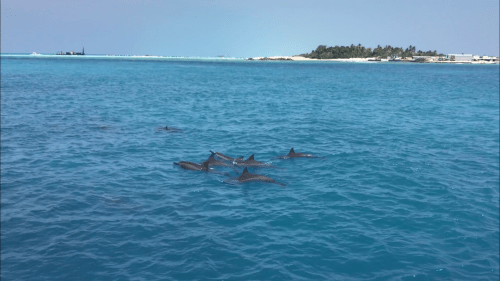
That is not to say that the islands are relaxing for everybody. The Maldives have the 7th highest incarceration rate in the world, and Islamic Sharia law is in full force here- homosexuality is illegal, flogging is a common punishment, and extramarital relations are outlawed. In February of 2018, the then-President (who was half-brother to the President from 1978-2008) declared a state of emergency and had several judges arrested, which was followed by mass protests in the streets of Malè. However, in September 2018, a new president was elected, who ran on a platform of upholding human rights, including releasing several political prisoners.
And so- the Maldives remain a unique tourism spot in the world. Wholly populated by Muslims, but selling pricey licenses to resorts to sell alcohol and pork to their guests. All Maldivian women wear the hijab, but western (and Chinese and Indian) tourists wear shorts on the streets and bikinis on the beach. The islands may not survive another fifty years, but 10-story hotels are being constructed at a rapid pace. With a new president and political party in power, the world will be watching to see how they face upcoming challenges.
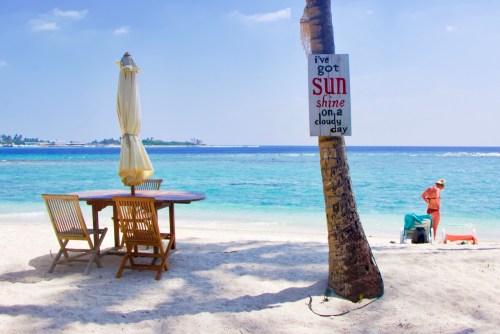
Next up for us: we fly to Mauritius, to hop on a cruise of the “Vanilla Islands”!
Maldives Country Costs:
Flight from Mumbai: $116 each
Visas: free
Daily costs: about $140 for two (slightly higher than normal for us because of scuba diving four times each)

Hey Deah, great blog piece. I learnt a couple of new things about the Maldives. Thanks 😉
How did you find the prices? Was it expensive to travel around and between the islands? Cost of hotels, activities, restaurants etc?
I’d love to visit but was always under the impression it was really expensive
Thanks
LikeLike
Hey there! We found that small hotels/guest houses ran in the $50-60 range on both Malè and Thulusdhoo. Dinners out could be as much as $50 if we wound up at a restaurant geared to tourists or as low as $10 (for two of us) if we ate at places that local residents ate at/suggested to us. To get to our island, there was a twice-a-day speedboat (40 minutes) that was $30 per person, or a public ferry that took 90 minutes that cost $3 per person. To get from island to island, you mainly need to go back to Malè, except most “local” islands have at least one nearby resort island that you can do a $100 day trip to (includes speedboat, lunch, drinks, pool etc). (We didn’t do that option but I saw it offered). The scuba diving we did was $60 each dive, which is pretty on par with other diving we’ve done.
Hope that helps! The main thing is getting the flight to there, which from India is pretty inexpensive. We transited through Mumbai- be sure to check their transit requirements!
LikeLike
This place looks insanely beautiful! We really hope to make it there one day! Really well written! Great work!
LikeLike
Thanks guys! I hope you can visit one day!
LikeLike